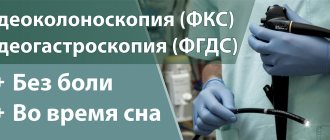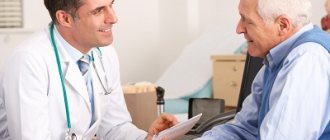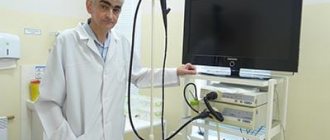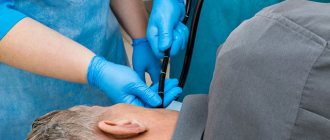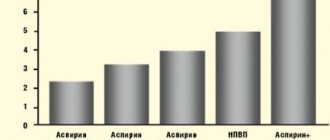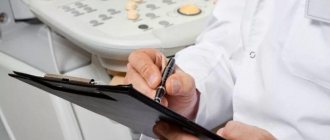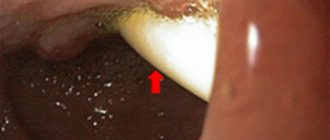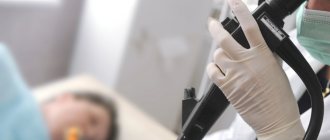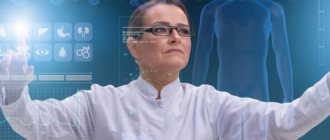Gastroscopy helps the doctor evaluate various symptoms, which include persistent epigastric pain, nausea, vomiting, or difficulty swallowing. This is an excellent test for finding and treating the cause of upper GI bleeding. Gastroscopy is also a more accurate study than fluoroscopic methods for detecting changes in the mucous membrane of the esophagus, stomach and duodenum, characteristic of inflammation, erosions, ulcers or oncological or other processes. The specialist may do an upper endoscopy to obtain a biopsy (soft tissue samples). A biopsy is done to rule out a number of causes, but most often to diagnose celiac disease or to test for Helicobacter pylori, a bacterium that causes recurrent gastroduodenitis, or peptic ulcers of the stomach or duodenum. From time to time, a biopsy is performed to distinguish between benign and malignant (tumor) tissue. Gastroscopy is also used for therapeutic purposes, to stop bleeding, remove polyps or apply topical medications.
How to prepare for the procedure
Preparation for the procedure has specific features. It is important that the procedure be carried out strictly on an empty stomach, because the food eaten will prevent you from seeing all the changes on the mucous membrane. Therefore, it is necessary not to eat or drink for at least 6 hours before the procedure, and it is also not recommended to smoke.
Content:
- How to prepare for the procedure
- Why do gastroscopy?
- Sedation and anesthesia
- Types of gastroscopy
- Gastroscopy and colonoscopy on the same day
- What happens during the procedure
- Side effects and complications of gastroscopy
- Gastroscopy in children
If there is still a need to drink water, for example, to wash down medications that the patient needs for life, then they can be taken with small sips of water, but after this you must inform the doctor conducting the study. Due to the fact that the procedure is performed on an empty stomach, patients are scheduled for examination in the first half of the day.
Patients with asthma are allowed to use the inhaler as directed. Smokers are advised not to smoke at least 6 hours before the procedure.
It is very important to inform the doctor 5 days before the gastroscopy about any medications the patient is taking, as the dose may need to be adjusted, or even completely stopped taking certain medications, such as iron supplements, antacids, antisecretory and blood thinners. You should discuss any allergies to medications, as well as underlying medical conditions such as heart or lung disease, with your doctor.
Diet before gastroscopy
On the eve of endoscopy, the diet should be as light as possible throughout the day; in the evening, a light dinner in the form of stewed vegetables with boiled chicken or fish. In this case, the serving is supposed to be no more than 350 grams. Next, fasting for 12 hours before the study, since during this time the stomach has time to fully digest and evacuate what has been eaten.
The volume drunk on an empty stomach should not exceed 300 ml. Large amounts of fluid may cause vomiting when the endoscope is inserted; You are only allowed to drink water, as other liquids can cause the production of hydrochloric acid.
If these conditions are met, nothing will interfere with the endoscopy.
Why is gastroscopy needed?
Duration of the study
: 15-30 min.
Preparing for the study
: There is
Contraindications
: No
Preparation of the conclusion
: 40 min.
Restrictions
: No
Many dangerous gastrointestinal diseases are asymptomatic, which often leads to irreversible consequences. This is why timely and correct diagnosis is important. First of all, this is gastroscopy.
What is gastroscopy?
Gastroscopy (full name esophagogastroduodenoscopy or EGDS) is an endoscopic examination of the upper gastrointestinal tract (esophagus, stomach and duodenum). She helps the doctor visually examine these organs using a special instrument - a gastroscope. It is made in the form of a thin flexible tube with a backlight and a camera at the end.
The image obtained from the lens is magnified many times over, and a detailed picture of the mucous membrane is reflected on the screen. The image can be recorded on film and used later for comparison.
Why do gastroscopy?
This study is prescribed to determine pathologies of the digestive tract, because often the symptoms of different gastrointestinal diseases are similar. This includes heartburn, belching, bitterness in the mouth, epigastric pain, etc. Gastroscopy helps to reveal the truth. It has long replaced X-rays with its accuracy and safety.
Important! Gastroscopy allows you to identify gastrointestinal pathologies, infections, ulcers, erosions, foreign bodies, polyps, causes of vomiting, bleeding, etc.
For what diseases are they referred?
Gastroscopy is indicated for suspected:
- inflammation, erosion, ulcers of the gastric mucosa, esophagus and duodenum;
- diverticulosis;
- oncology;
- bleeding;
- casts.
Preparation for the procedure and methodology
Preparatory activities:
- The last meal should be no later than 8 hours before the procedure, preferably 10–12 hours.
- Eliminate spicy food and alcohol for 2 days.
- Avoid smoking 4–6 hours before the procedure.
Important! Gastroscopy is usually performed in the first half of the day, as it should be done on an empty stomach.
Methodology:
- The patient lies on the couch on his right side, his back is straight and his legs are bent. To block the gag reflex and relax the larynx, 10% lidocaine is sprayed onto the root of the tongue.
- A mouthpiece is inserted into the mouth and has a hole for the endoscope tube.
- The tip of the tube, lubricated with gel for better glide, is inserted into the larynx and further to the stomach. The doctor administers the drug during swallowing. You need to breathe when inserting the probe according to the doctor’s command.
- The specialist supplies water or air into the stomach to straighten the folds of the mucous membrane. The design has a special suction that helps with this.
- The mucous membrane is examined, after which the probe is removed. The usual duration is 5–10 minutes. If necessary, treatment measures may take up to 15–20 minutes.
Contraindications
Absolute contraindications:
- heart or respiratory failure;
- suffered a stroke or heart attack;
- aortic aneurysm;
- severe atherosclerosis;
- acute inflammatory processes in the oral cavity or pharynx;
- exacerbation of bronchial asthma;
- decreased blood clotting;
- esophageal stenosis.
Relative contraindications:
- pregnancy;
- thyroid enlargement;
- stomach bleeding;
- dilated veins of the esophagus.
Types of gastroscopy
Esophagogastroduodenoscopy can be:
- planned;
- emergency;
- diagnostic;
- preventive;
- medicinal.
Also isolated transnasal, during sleep and under anesthesia.
Gastroscopy in a dream
Abroad (in Europe, Israel, the USA, Japan) this procedure is considered basic. In Russia - only according to the patient’s personal desire and ability to pay. Also, gastroscopy in a dream is indicated for psychosis, the need for frequent manipulations, and for young children. After administration of the drug, the person falls asleep for 10–15 minutes. This is enough to conduct the study.
Transnasal gastroscopy
The probe is inserted through the nasal passages. The advantage is the absence of a gag reflex. For ARVI and nasal congestion, the procedure is not performed.
Capsule gastroscopy
The patient simply swallows the capsule with water, like a tablet. It already has a built-in video system and sensor. It passes freely through the entire gastrointestinal tract, transmitting an image of the walls of the internal organs to the doctor’s computer. The capsule is removed naturally. The downside is the high cost and incompleteness of the resulting picture.
Which doctor can refer you for the test?
A referral for testing can be obtained from a gastroenterologist or attending physician who knows the patient’s medical history.
Is it possible to get by with an ultrasound or other studies?
Ultrasound, CT, and MRI do not provide an accurate picture of the condition of the mucous membrane. These studies do not allow the collection of physiological fluids for examination or material for biopsy. They can only evaluate the external picture of the organ. They will not be able to detect, for example, a tumor in the early stages or gastritis.
How often can a gastroscopy be done?
As often as required. This is determined by the attending physician depending on the diagnosis.
Believe me, no one will crawl into your stomach out of simple curiosity. And if your doctor has referred you for an examination, you definitely need it.
| Name of service | Price in rubles | Price until 31.05. |
| Gastroscopy (fibrogastroduodenoscopy) | 3 100 | 2 299 |
| Gastroscopy “in a dream” | 6 100 | 5 499 |
| Endoscopic express pH-metry (determination of gastric acidity) | 1 250 | |
| Comprehensive examination (gastroscopy + determination of acidity + determination of Helicobacter pylori + sampling of material) | 6 400 | 4 199 |
If you do not find a service in the price list, please call us and we will provide you with the necessary information.
Our doctors will help you:
Endoscopist
Nitsenko Alla Yurievna
Endoscopist
Nurzhauov Nurlan Mukhamedovich
Endoscopist, gastroenterologist
Osipova Inna Vitalievna
Why do gastroscopy?
With gastroscopy, the doctor is able to visualize the mucous membrane of the upper gastrointestinal tract from the esophagus. Gastroscopy is effective and has replaced the use of X-rays in many cases. This helps the doctor see any abnormalities in the duodenum, stomach, or esophagus. This method is accurate and safe.
Through the gastroscope, the doctor can take samples of the mucous membrane for examination and obtain video images using a video sensor installed at the end of the gastroscope. The examination can be videotaped and used for later diagnostic comparison.
Patients are often referred for gastroscopic examination due to symptoms of dyspepsia, which can usually be treated with medications. Dyspepsia is sometimes caused by a peptic ulcer, and it is now known that many ulcers are caused by a bacterial infection in the stomach. A biopsy is the removal of a small section of the mucous membrane followed by histological examination and is performed during gastroscopy to determine the presence of an infectious pathogen or other anomaly. In a very small number of patients with dyspepsia, a biopsy can detect malignant tumors in the upper gastrointestinal tract or conditions preceding malignancy, which is very important for therapeutic and diagnostic purposes. Further research may be planned to ensure the most effective treatment.
Gastroscopy will help:
- Find problems in the upper gastrointestinal tract. These problems may include: inflammation of the esophagus (esophagitis) or stomach (gastritis), gastroesophageal reflux disease (GERD), narrowing (stricture) of the esophagus, varices in the esophagus, Barrett's esophagus, which can significantly increase a person's risk of developing esophageal cancer, hiatal hernia, ulcer, cancer.
- Find the cause of bloody vomiting or hemoptysis.
- Find the cause of symptoms, such as abdominal pain or bloating, trouble swallowing (dysphagia), vomiting, or unexplained weight loss.
- Find the cause of the infection.
- Check the healing of ulcers during therapy.
- Look at the inside of the stomach and upper small intestine (duodenum) after surgery.
Gastroscopy can also be performed in the following cases:
- To check for injury to the esophagus in an emergency (for example, a burn if a person drank acetic acid).
- To collect tissue samples (biopsy) that need to be subjected to microbiological examination.
- To remove polyps from the small intestine, stomach, esophagus.
- For the treatment of upper gastrointestinal bleeding that may cause anemia.
- To remove foreign objects that have been swallowed.
Interesting movie
The endoscope is a long, thin flexible tube with a diameter of up to 1 cm. It is equipped with a special light source.
A traditional optical endoscope has a lens at the end. The image is transmitted via a special fiber to the eyepiece into which the doctor looks. Recently, video endoscopes have become increasingly widespread. At their end there is a mini video camera that transmits the image to a computer monitor. The image with video endoscopy is clearer, it can be enlarged and studied in more detail.
There are also therapeutic endoscopes. Through the thin channel of such devices, instruments for therapeutic manipulations can be passed into the gastrointestinal tract. Such devices allow not only to examine the mucous membrane, but also to perform a biopsy (taking a small piece for analysis in the laboratory), and, if necessary, remove polyps, foreign bodies, and carry out hemostatic measures.
By the way, the gastroscopy technique is well established. Because of this, the procedure is quite safe, and complications are extremely rare. After the examination, my throat often feels sore. This is a common phenomenon that should not cause alarm - discomfort, as a rule, disappears a day after the examination or earlier.
Article on the topic
Gastroscopy. 5 signs you need this procedure
Sedation and anesthesia
Before the gastroscopy procedure, the patient's pharynx is treated with the anesthetic lidocaine. This is necessary in order to reduce pain and other negative effects that occur when swallowing the device. At the client's request, gastroduodenoscopy of the stomach is performed under anesthesia. In this case, intravenous anesthesia is administered, which causes relaxation and light sleep. Patients wake up within an hour, but the effects of the drugs are longer lasting, making it unsafe to drive until the next day. General anesthesia for medical reasons is provided only in special cases (in young children and when planning very complex procedures).
Types of gastroscopy
Typically, an endoscope has a channel through which, if necessary, the instrument can be passed at any time to perform a biopsy, treatment, or other manipulation. These tools include:
- flexible forceps - an instrument used to take a tissue sample;
- biopsy forceps, which are recognized for removing a tissue sample or suspicious lesion;
- a cytology brush, which is used to collect cell samples;
- pliers for removing sutures.
Endoscopy can be not only a diagnostic procedure, but also a therapeutic one; it can be used to:
- Surgery using just small cuts in the skin, called laparoscopic surgery.
- Laser therapy uses a powerful beam of light to kill cancer cells.
- Microwave ablation, which uses heat to destroy cancerous tissue.
- A surgical operation using an endoscope that is inserted into the gastrointestinal tract, this operation is called endoscopic mucosal resection.
- Photodynamic therapy, which, after injecting tissue with a light-sensitive drug, destroys the tumor using a laser.
- Administration of medications.
Transnasal gastroscopy
Transnasal gastroscopy, which is performed through the nose, is much easier to tolerate than the traditional method through the mouth, because the intranasal route of administration does not cause a gag reflex. This method is mainly used in elderly patients with a complex of concomitant diseases. Patients can speak if necessary during the procedure. This means that fewer patients require sedation, and it means that patients can continue with their daily activities after the procedure.
Capsule gastroscopy
Capsule gastroscopy is a procedure that uses a tiny wireless camera to take pictures of the digestive tract. The camera is located inside a small capsule that the patient swallows. As the capsule passes through the digestive tract, it takes thousands of images, which will then be transmitted to a recording device. This method is performed without swallowing the probe, as with traditional gastroscopy. The procedure is considered complete after the capsule leaves the body naturally. This method is not used as often as endoscopic gastroscopy. The main disadvantage of the method is its considerable cost.
Gastroscopy and colonoscopy on the same day
The efficiency of same-day gastroscopy and colonoscopy has many potential benefits, as it can reduce costs, shorten hospital stays and speed up patient care. General indications for these endoscopy methods are hidden or overt gastrointestinal bleeding, a history of relevant pathology (polyps, ulcers), unspecified abdominal pain, diarrhea or other symptoms, radiological studies and iron deficiency anemia. The practice of one-day gastroscopy and colonoscopy is possible, has excellent diagnostic yield even in older people and does not carry increased risks. When indicated, the practice of conducting one-day studies should be encouraged.
What happens during the procedure
Shortly before gastroscopy, the mouth and throat are anesthetized using an aerosol. All dentures must be removed before the procedure. The patient may be given a sedative. The time of gastroscopy is about 5-10 minutes, it may be longer, depending on the purpose of this procedure. Usually the procedure is performed in a lying position on the left side; in some exceptional cases, gastroscopy is performed while standing. A small tube or protective ring is placed between the teeth to keep the mouth open and prevent the patient from biting the gastroscope. First, the patient is asked to take a swallow so that the gastroscope can enter the esophagus. It is then slowly pushed into the stomach and down to the opening of the duodenum.
Using video images, the doctor monitors the advancement of the probe and visualizes the area of suspected disease. Bleeding, varicose veins, unusually narrow passages and stomach ulcers can also be seen on the screen. If necessary, a tissue sample will be taken for subsequent microbiological examination, which is not painful for the patient.
Let's get ready and do it
2-3 days before the study, you should not consume spicy foods, strong alcoholic drinks, or drugs based on acetylsalicylic acid. They irritate the gastric mucosa, which is why gastroscopy results may be unreliable. You should not eat or drink for 8–10 hours before the test. Food and liquid in the stomach can make it difficult to examine and make a correct diagnosis. And before starting the procedure, you need to tell your doctor if you are allergic to any medications.
Before gastroscopy, the patient is allowed to gargle with a local anesthetic solution or spray it with a spray bottle (this is necessary to reduce the sensitivity of the pharynx). After 1–3 minutes, numbness occurs in the mucous membranes of the mouth and pharynx. After this, the patient clamps a mouthpiece between his teeth, through which the endoscope is passed. The passage of the tube from the throat into the esophagus is accompanied by rather unpleasant sensations. To bear this moment easier, you need to take a breath, completely relax, and then take a sip, during which the doctor will insert the endoscope.
For children under 6 years of age and particularly sensitive people, gastroscopy is usually performed under short-term general anesthesia.
If the purpose of the examination is to diagnose a particular disease, the procedure usually lasts about 2–3 minutes. If therapeutic manipulations are necessary, it can take up to half an hour.
The conclusion is usually issued within 1–2 hours. Biopsy results within a week.
Side effects and complications of gastroscopy
Most gastroscopy is performed without any problems or complications. Some people may experience mild inflammation of the throat lining for a day or so.
The patient may feel tired or drowsy for several hours if a sedative was used during the procedure. There is a slightly increased risk of developing a chest infection or pneumonia after a gastroscopy.
Sometimes the endoscope causes some damage to the intestines. This can cause bleeding, infection, and (rarely) a hole (perforation). If any of the following symptoms occur within 48 hours after gastroscopy, you should contact your doctor immediately:
- pain after the procedure in the abdomen (particularly if the pain gradually becomes worse and differs in intensity from any “normal” stomach pain);
- increased temperature (fever);
- labored breathing;
- vomiting blood.
A small number of people have had a heart attack or stroke during or shortly after a gastroscopy. This tended to occur in older people who had underlying heart or lung problems.
Some people have an allergic reaction to the anesthetic, but this is discussed before the procedure.
After the prescribed examination, consult with your therapist.
If gastritis was detected during the research, it is necessary to additionally diagnose helicobacter pylori. This can be done using several tests: determination of antibodies in the blood (if the patient has not previously been treated for this infection); examination of biopsy samples of the gastric mucosa.
Some stomach diseases require adherence to a certain diet; your doctor will tell you about the required diet. The patient must strictly follow all prescriptions throughout the entire treatment period. The duration of treatment is also determined by the doctor, who also sets a date for re-examination. After completion of treatment, it is necessary to evaluate its effectiveness; this can be done only a month after stopping the medication.
